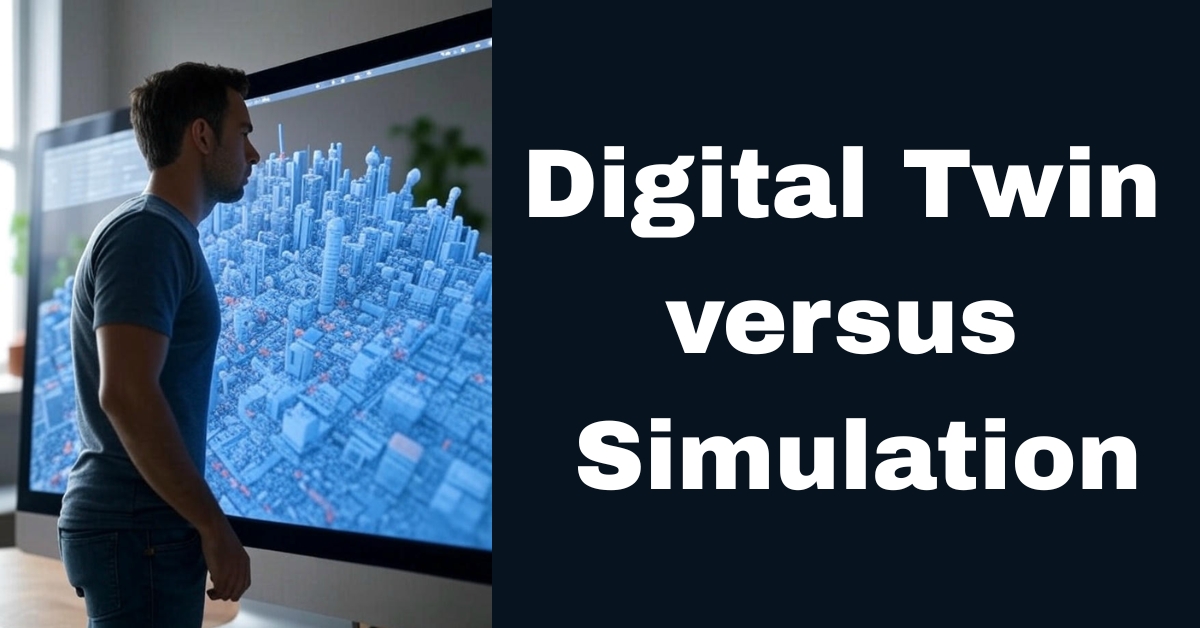Table of Contents
🧭 Introduction
As businesses embrace digital transformation, two terms often come up: digital twin and simulation. While both offer virtual representations of physical systems, the difference between them is significant.
At Twin Labs, we help South African companies harness digital twins for real-time monitoring and advanced decision-making—going far beyond traditional simulation models.
🧪 What Is a Simulation?
A simulation is a static model that mimics the behavior of a system under specific conditions. It’s used to test “what-if” scenarios before implementation.
Example:
Engineers simulate how heat flows through an engine block to test cooling system designs.
Limitations:
- Based on assumptions
- Not updated in real-time
- Often a one-time use for analysis
🤖 What Is a Digital Twin?
A digital twin is a real-time, dynamic virtual replica of a physical object, process, or system. It continuously receives live data through IoT sensors, making it adaptable and predictive.
Example:
A smart factory uses a digital twin to track machinery wear in real-time and automatically alert maintenance teams before breakdowns occur.
Capabilities:
- Real-time synchronization
- Bi-directional communication
- Predictive analytics and automation
🆚 Key Differences Between Digital Twin and Simulation
| Feature | Simulation | Digital Twin |
|---|---|---|
| Data Flow | One-time, static | Continuous, real-time |
| Purpose | Testing assumptions | Ongoing optimization & control |
| Interactivity | Limited | Fully interactive & responsive |
| Data Source | Assumptions or historical data | Live sensor data |
| Usage Lifecycle | Pre-build and analysis only | Throughout design, operation & repair |
📈 Why Digital Twin Matters More Today
In the age of Industry 4.0, static simulations are no longer enough. Businesses need dynamic systems that evolve with reality—and that’s where digital twins shine.
Use Cases Driving the Shift:
- Smart city planning with live infrastructure models
- Manufacturing process optimization with real-time data
- Predictive maintenance in energy and transport sectors
🔧 When to Use a Simulation vs. Digital Twin
Use Simulation when:
- You’re in early design or R&D stages
- You don’t need live data
- Cost and simplicity are priorities
Use Digital Twin when:
- You need ongoing insights from physical assets
- Operational uptime and predictive maintenance matter
- Your business operates in a dynamic, data-rich environment
🌐 Real-World Example: Twin Labs in Action
At Twin Labs, we implemented a digital twin system for a local logistics company. By connecting real-time GPS and sensor data to a digital twin of their fleet, we helped reduce fuel costs by 14% and cut downtime by over 25%.
💡 Conclusion
While simulations help you plan, digital twins help you evolve. In a competitive, real-time world, static models can only take you so far.
🌟 Partner with Twin Labs 🌟
As South Africa’s premier AI Twin specialists, Twin Labs helps you plan, implement, and manage custom virtual modeling systems tailored to your business.
Services Offered by Twin Labs
- Consulting & Feasibility Studies: Twin Labs helps businesses analyse the viability and ROI of digital twin initiatives. This includes technical feasibility, data infrastructure evaluation, and business-case development. Consultants work with clients to identify high-impact use cases, outline implementation roadmaps and assist leadership with AI strategy.
- Developing AI Agents: Twin Labs builds intelligent software agents and digital assistants that interact with a digital twin. These agents can monitor the twin, analyze data, and recommend actions (e.g. triggering maintenance alerts or adjusting parameters). The firm applies agent-based modeling to create dynamic, automated layers on top of the digital twin platform.
- Decision Intelligence: Leveraging data analytics, Twin Labs constructs decision-support frameworks within the twin. This includes dashboards and predictive algorithms that enable executives to make informed decisions. Our services encompass data integration, rule engines, and AI/ML models to extract insights from twin data, effectively turning the twin into a decision intelligence system.
- Predictive Modelling: Using machine learning and statistical techniques, Twin Labs develops predictive models for twin applications. For example, they may build failure-prediction or demand-forecasting models that run in conjunction with the twin. These predictive analytics functions enrich the twin with foresight capabilities, such as forecasting equipment wear or production yields.
- Custom Digital Twin Development: Twin Labs offers turnkey development of digital twins tailored to client needs. This includes creating 3D representations, integrating IoT data streams, and coding the simulation logic. They provide solutions for specific industries and assets, customizing the twin’s data model and visualization. Essentially, they can deliver a complete twin platform (software + model) that reflects the client’s physical system.
Through these services, Twin Labs guides companies from strategy through implementation of digital twin solutions. Our approach combines consultancy, data science, software development, and industry expertise to build and deploy twins that solve real business problems.
📞 Contact us today to schedule a free consultation and discover how a digital twin can revolutionize your operations. Call 075 123 000
